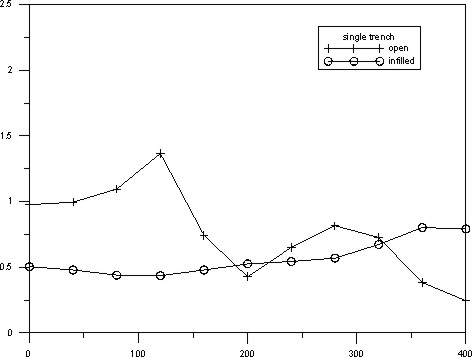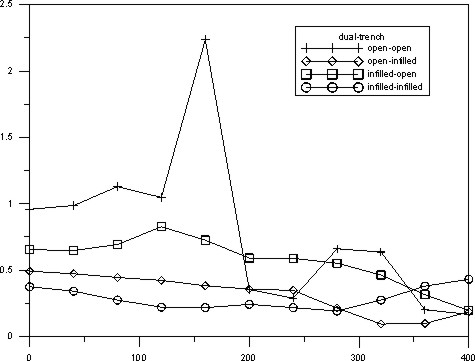
engineering & technology publications
ISSN 1759-3433
PROCEEDINGS OF THE TENTH INTERNATIONAL CONFERENCE ON CIVIL, STRUCTURAL AND ENVIRONMENTAL ENGINEERING COMPUTING
The Isolation Efficiency of the Dual-Trench System in a Three Dimensional Wave Propagation Problem
+Department of Civil and Environmental Engineering, National University of Kaohsiung, Kaohsiung, Taiwan
*Department of Construction Engineering, National Kaohsiung First University of Science and Technology, Kaohsiung, Taiwan
|
There is much research on vibration isolation using a single trench. A previous study [3] indicates that the isolation efficiency of a trench varies with the fill material. The trench with stiffer material has better isolation efficiency in a low frequency case and the empty trench has better isolation efficiency in a high frequency case. In the present analysis, the efficiency of a combination isolation system of two parallel trenches is evaluated with the aid of the boundary element method [1,2].
The efficiency of the vibration isolation of a dual-trench system is investigated in the present analysis. Three different dual-trench systems, the open-open, open-infilled, and infilled-infilled combinations are studied. The research results are shown in Figure 210.1, which show that the system with open-open or infilled-infilled trenches have the similar efficiency to that of a single open or single infilled trench. The combination system of open-infilled trenches is an ideal isolator in both low and high frequency cases.
- 1
- Banerjee, P.K., The Boundary Element Methods in Engineering, McGraw-Hill, London, 1994
- 2
- Brebbia, C.A., Telles, J.C.F. and Wrobel, L.C., Boundary Element Techniques in Enginnering, Butterworths, 1980
- 3
- Shih-Heng Tung, "Beitrag zur dreidimensionalen numerischen Berechnung der Wellenausbreitung und -abschirmung im elastischen Halbraum", Dissertation, RWTH-Aachen, Germany, 2002
- 4
- Shih-Heng Tung, Ming-Shan Shih, "Study on the influence of high speed railway's bridge span in the surface wave propagation of microvibration", Proceding of the 6th Conference on Structure Engineering, Kenting, Taiwan, 2002 (in Chinese)
- 5
- Dasgupta, B., Beskos, D.E. and Vardoulakis, I.G., "3-D Analysis of Vibration Isolation of Machine Foundations", Boundary Element X - Geomechanics.
- 6
- Fuyuki, M. and Matsumoto, Y., "Finite Difference Analysis of Rayleigh Wave Scattering at a Trench", Bull. Seism. Soc. Amer., Vol. 70, 2051-2069, 1980.
- 7
- Segol, G., Lee, P.C.Y. and Abel, J.E., "Amplitude Reduction of Surface Wave by Trenches", Proc. ASCE 104, Journal of Engineering Mechanics, Div. EM3, 621-641.
- 8
- Emad, K. and Manolis, G.D., "Shallow Trench and Propagation of Surface Waves", Journal of Engineering Mechanics, ASCE, Vol. 111, No. 2, 279-282, 1985. doi:10.1061/(ASCE)0733-9399(1985)111:2(279)
- 9
- Beskos, D.E., Dasgupta, B. and Vardoulakis, I.G., "Vibration Isolation of Machine Foundations", Vibration Problems in Geotechnical Engineering, Gazatas, G. and Selig, E.T., eds. ASCE, New York, 138-151, 1985.
- 10
- Ahmad, S. and Al-Hussaini, T.M., "Simplified Design for Open and In-Filled Trenches", ASCE, Journal of Geotechnical Engineering, Vol. 117, No. 1, Jan., 67-88, 1991. doi:10.1061/(ASCE)0733-9410(1991)117:1(67)
- 11
- Klein, R., Antes, H. and Le Houedec, D., "Efficient 3D Modelling of Vibration Isolation by Open Trenches", Comput. Struct., Vol. 64, 809-817, 1997. doi:10.1016/S0045-7949(96)00418-X
purchase the full-text of this paper (price £20)
go to the previous paper
go to the next paper
return to the table of contents
return to the book description
purchase this book (price £135 +P&P)

